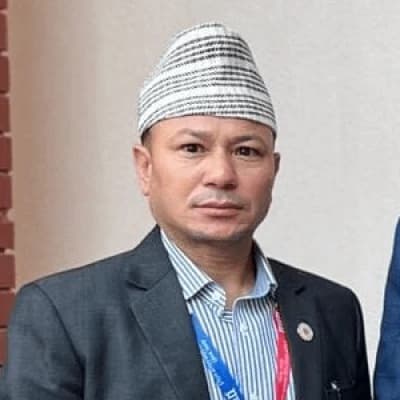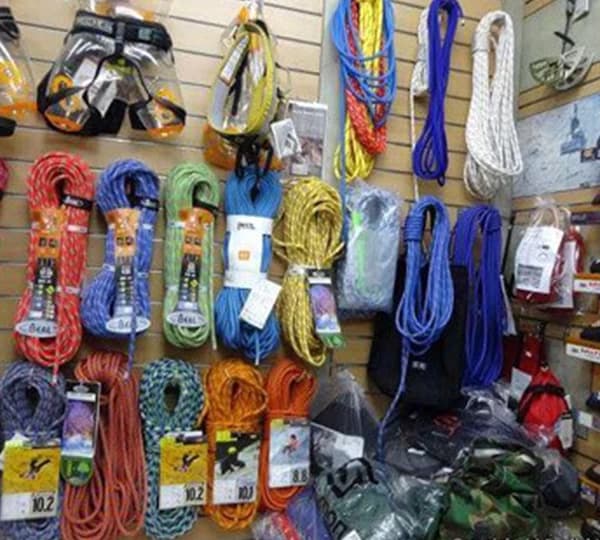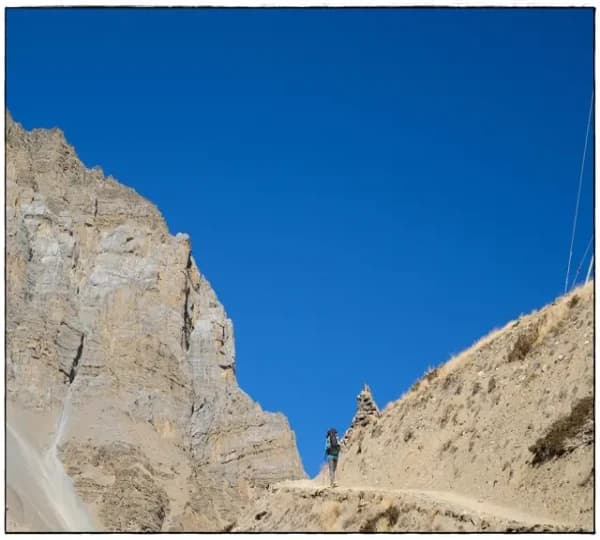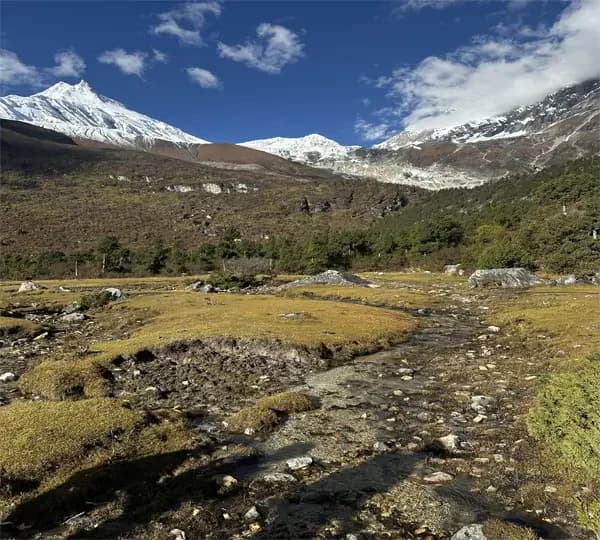Why Manaslu Circuit Trek in Nepal?
The Manaslu Circuit Trek is an off-the-beaten-path trek in the north-west of Kathmandu. Please forget about the traditional trekking route and go to the caravan. Global Adventure Trekking is just a 14-day trek starting in Kathmandu and ending in Kathmandu. The total length of the trek is 177 km/109 miles and offers unique and mesmerizing views of the landscapes and mountains, including Manaslu (8,163 m/26,774 ft) and Annapurna II, a vast range of flora and fauna, glacier lakes, and monastery life. Trekking in the Manaslu circuit is a lifetime of experience. Manaslu Circuit Trek is a less crowded trekking trail than Everest Base Camp, Langtang Valley Trek, and Annapurna Circuit Trek. You can enjoy the trek with peace and natural beauty as you are away from the hustle and bustle.
Manaslu circuit trek highlights:
-
The intermingling of local Buddhism and Tibetan culture with warm hospitality
-
Circle Mt. Manaslu through the shadows of Manaslu and its neighboring mountains.
-
Flawless landscape, river, forest, flora, and fauna
-
Cross Manaslu Valley to Annapurna Valley over the Larkye La Pass (5,106 m./16,746 ft.)
-
Off-The-Beaten-Trail experience
-
Eight of the highest Mountains in the World
Manaslu Trek difficulty level:
The Manaslu Circuit Trek is considered a challenging trek due to its demanding terrain and high altitude. The trek involves steep ascents and descents, with some trails being narrow and rugged, requiring good physical fitness and stamina. One of the most challenging aspects is crossing the Larkya La Pass, which stands at 5,135 meters (16,847 feet). The high altitude poses a risk of altitude sickness, making acclimatization crucial. Additionally, the remote location of the Manaslu region means fewer facilities and support services along the way, adding to the difficulty. Overall, the combination of tough terrain, high altitude, and limited resources makes the Manaslu Circuit Trek a demanding but rewarding adventure.
Trek Permit and fees for Manaslu circuit:
As per the rules of the Nepali government, all permits are required to accomplish this trek. The border to Tibet is open to the locals, and to avoid illegal activities, everyone should obtain the necessary permit before they start the trip to Kathmandu through a government-recognized trekking company. Only a group permit is issued for the restricted area; we need at least 2 people to trek together.
Restricted Area Permit (RAP):
- It is necessary for all trekkers.
- Cost: US$100 Sep-Nov, USD$70 Dec-Aug per week for the first 7 days, then US$ 15/10 per day thereafter.
- SAARC nationals: US$10 per week.
- Nepali nationals: NPR 1,000 per week.
Manaslu Conservation Area Permit (MCAP):
- Required for all trekkers.
- Issued by the Manaslu Conservation Area Project (MCAP) office or authorized agencies.
- Cost: NPR 3,000 (approx. USD 30) for SAARC nationals
- NPR 1,000 (approx. USD 10) for Nepali nationals
- USD 30 for other nationals.
Annapurna Conservation Area Permit (ACAP):
- Required if you choose to exit the trek via the Annapurna region.
- Issued by the Annapurna Conservation Area Project (ACAP) office or authorized agencies.
- Foreigners: NPR 3,000 per person
- SAARC Nationals: NPR 1,000 per person
- Nepali: NPR 100 per person
Cost Variation:
• Peak Season (September to November): Expenses are normally higher as a result of more vacationers. Alcoholic beverages will be more expensive, while accommodation and food charges are expected to be on the higher side, but the permit fees will remain the same as before.
• Off-Peak Season (December to August): The costs can be lower; however, some teahouses might be unavailable. There are no changes to the fees for the permit.
• Winter and Monsoon Season: The prices could be generally lower since it is not preferred by many trekkers because the weather is harsh in these seasons.
I am a solo traveler; how can I do it?
The Manaslu Circuit Trek is becoming a more popular trek destination in Nepal. If you are solo and looking for a trekking partner, then don’t worry; Global Adventure Trekking Company always has some other people to join. So, we are here to support you and make it happen. You have to join our scheduled departure group trip.
As a solo traveler planning to trek the Manaslu Circuit, it's important to note that the region is classified as a restricted area, and trekking here requires you to be part of a group with at least two trekkers. Additionally, you must hire a licensed guide or porter. This regulation is in place to ensure the safety and well-being of trekkers, as the route passes through remote and challenging terrain where self-sufficiency can be difficult.
To comply with this requirement, you can join a group organized by a trekking agency. Many agencies in Kathmandu offer group treks where you can team up with other solo travelers. These agencies handle all necessary permits, logistics, and guide arrangements, making the planning process much easier for you.
Alternatively, if you prefer more flexibility, you can connect with other trekkers via online forums, trekking communities, or social media platforms. Finding a trekking partner through these channels can help you meet the minimum group size requirement while also sharing the experience with like-minded adventurers.
The best time for the Manaslu Trek:
The two ideal seasons to trek the Manaslu Circuit are the spring season and the autumn season, though hikers can attempt it throughout the year. Ideally, during these periods, the climatic conditions are rather cool and dry, perfect for sightseeing the surrounding topography. The temperatures are moderate and thus appropriate for trekking during the day, while at the same time being polite for camping at night. Moreover, during the spring season, the rhododendron flowers bloom all along the territory of the trail, and the forests look gorgeous.
During this season, flowers grow, and the weather is comparatively dry and stable for trekking on the trails of the season. Autumn does not have problems such as muddy roads and hazy skies, so this is the best time for taking pictures of the mountain. These seasons also include cultural programs like festivals, which the trekkers can encounter while on the trekking expedition.
As a result, the area turns green during the monsoon period of June–August, but nothing can be as terrible as the heavy rainfall that accompanies this weather condition or the danger of being trapped in a landslide. Much like the monsoon season, winter can be dangerous for trekking as well due to its cold temperature and snow, particularly from December to February. It is thus advisable to take on the Manaslu Circuit Trek during the spring and autumn seasons when the weather is more favorable for trekking.
Manaslu Trek weather:
Spring (March to May):
The climate of the Manaslu Circuit Trek is quite good during the spring because of its moderate temperatures and clear blue sky. It is warm, with temperatures ranging from 10 degrees Celsius to 20 degrees Celsius in the lower parts of the day. Some parts may be cool in the morning and at night, but with a few showers, it is one of the best times for trekking. The countryside blossoms with rhododendrons, making the valleys and hills as green as an emerald, with splashes of color here and there.
Summer/Monsoon (June to August):
During the summer or monsoon season in the Manaslu region, there is heavy precipitation that makes trekking difficult and sometimes risky. Some of them get flooded; some turn into swamps; the terrain becomes slippery; and there are possibilities of landslides, especially when the paths are through steep slopes. It can still be warm during the day, with average temperatures between 15 and 25 degrees Celsius near sea level; however, it rains constantly, the skies are overcast, and it is impossible to see the mountains. It is advisable not to trek during this season due to the harsh climatic conditions and increased cases of instability.
Autumn (September to November):
However, many consider autumn to be the best time to hike the Manaslu Circuit. The weather during this season is characterized by cool, dry, and clear conditions during the mornings, and warm and sunny conditions during the afternoons. The temperatures range from 10 degrees Celsius to 20 degrees Celsius during the day, especially in low-altitude regions, which are good for trekking. The weather is fairly decent, with few clouds providing a stunning vista of the snowy mountains and the surrounding terrain. This season also comes along with other festivals within the area, which makes the trekking experience even more colorful.
Winter (December to February):
The winter season consists of cold temperatures with occasional snow at the higher elevations in and around the Manaslu area. The lowland region experiences daytime temperatures of 5 degrees Celsius up to 15 degrees Celsius, while nights are considerably colder or freezing. Snow can hinder trekking, especially when crossing hills, mountains, or any region with high altitudes. However, the trails are less crowded, and the sky is blue, which makes for a very different and beautiful trekking experience if the cold does not bother you.
Necessary trek gear for the Manaslu circuit Trekking and Hiking:
The trekking gear plays an important role in making the trip successful. It depends on personal body choice and body temperature. Here is a list of the trekking gears
Here is a complete checklist of trekking gear and equipment for the Tsho Rolpa Trek.
Head:
- Trekking Hat/Cap
- Headlamp/Flashlight (with extra batteries), good quality
- Sunglasses (UV protection)
- Woolen hat /Beanie (for cold weather)
- Bandana/Buff (for dust and sun protection)
- Sunblock (Sunscreen) (SPF 40 or higher)
- Insect Repellent (any trekking areas)
Body:
- Base Layer Shirt: Two (moisture-wicking, breathable fabric)
- Trekking Jacket: A pair of lightweight (water-resistant/windproof)
- Insulating Layer: A pair (fleece, down jacket, or sweater for warmth)
- Rain Jacket/poncho (lightweight, waterproof)
- Trekking Trousers/Pants: Two pairs (comfortable and durable)
- Long-sleeve shirt: 1 pair (for sun or insect protection)
- Underwear: Two pairs (moisture-wicking, quick-dry fabric)
- Compression Garments (for reducing muscle fatigue, optional)
- Gore-Tex or a similar waterproof jacket
Lower Body:
- Trekking Pants: Two pairs (convertible into shorts if needed)
- Thermal Leggings: one (for cold weather)
- Shorts: Two (optional, for warmer weather)
- Knee Guards/Support (for those who need extra knee protection)
- Hands: Protect your hands with warm gloves
- Light inner gloves (for lower-elevation trekking)
- Insulated or down gloves (high-altitude trekking)
- Waterproof gloves (wet season)
Footwear:
- Trekking Boots/Shoes (comfortable, waterproof, with good grip and ankle support)
- Gaiters (to protect from mud, snow, or rocks entering boots)
- Thick Socks: Two pairs (merino wool or synthetic, moisture-wicking)
- Lightweight Socks: Two pairs (for warmer weather or layering)
- Sandals/Flip-flops (for campsite/rest stops)
Extra Suggested Items:
- Sleeping bag
- Drying towel
- Trekking Poles
- Cash (extra Nepali rupees for additional expenses)
- 60L+ Backpack (Rucksack) (with rain cover and hydration system)
- Hydration System/Water Bottles/Camelback
- Water Purification Tablets/Filter
- Snacks (Energy Bars, Dried Fruits, Nuts
- First Aid Kit (with basics like bandages and antiseptic, as per personal need)
- Multi-tool/Knife
- Trekking Map or GPS
- Portable Power Bank (to charge devices)
- Camera or Smartphone (to capture the views)
- Toiletries (toothbrush, toothpaste, biodegradable soap, shampoo, etc.) Feminine hygiene products as needed
- Wet wipes
- Emergency Whistle
- Dry bags
- Clothing Layer
- Duct Tape
- Hand sanitizer
- Fire-starting Kit (matches, lighters)
- Plastic Bags for Waste (Leave no trace principle)
- Notebook/Journal (for documenting the trip)
Manaslu Trek food:
The food is quite diverse in the Manaslu Circuit Trek—Nepali food and some options of Western style. Beverages—tea, coffee, hot chocolate, cooking wine, and snacks—are available from tea houses and lodges en route, and food can be scarce depending on the altitude and distance from civilization.
Some of the typical Nepali meals include Dal Bhat, which is rice and lentil soup accompanied by vegetables and sometimes meat; Momo, which are steamed dumplings filled with meat or vegetables; and Thukpa, which is noodles soup. Some of the main meals that trekkers find most appropriate for their energy requirements include Dal Bhat, which comes.
As for the choice of meals, almost every teahouse offers some Western food like pasta, pizza, pancakes, porridge, and others, but their quality and choice may not be as great as in restaurants in bigger cities.
One should avoid taking raw dishes, raw salads, or cross-contaminated foods to prevent instances of foodborne illnesses. Most teahouses also offer tea, coffee, and hot chocolate. Soft drinks and other beverages, both hot and cold, are good for those who have been trekking all day. Furthermore, most of the food items found in the cafes and restaurants along the Manaslu Circuit are simple yet satisfying, and this fulfills the hiker’s energy requirements involved in trekking at such altitudes.
Accommodation in Manaslu Circuit Trek:
Lodging facilities are lodged all along the Manaslu Circuit Trek, specifically in the form of teahouses or guesthouses, which are simple lodging establishments that provide numerous services to the trekkers. These teahouses are set up in villages along the trekking path and offer food and beverages, a place to meet and lodge with other trekkers.
The teahouses commonly provide spare and small rooms, most of which have twin beds or bunk beds, spare bedding, and WC/bath-sharing facilities. Teahouses may also have private rooms with bathroom facilities; however, they are limited in number, and the price may be a little steep.
A public field within the teahouses comprises a dining area where trekkers may take their meals, a lounge, and, at times, a small store that deals in food items, drinks, and trekking requirements. In addition, many of them also offer meals, which are breakfast, lunch, and dinner, and if they do, then, meals like buns are taken in a restaurant.
In some of the trekking terrains, there might be several standard endowments of the accommodation, but as one gets to the more interior villages, the endowment might be quite humble. It’s recommended to bring a sleeping bag because the bedding may be inadequate in the teahouses, particularly at high altitudes.
Transportation in Manaslu Circuit Trek:
Access to the Manaslu Circuit Trek is either a partly constructed road or a partly constructed trail. The first part entails a drive from Kathmandu to Machha Khola via Aarughat and Soti Khola. The starting areas of the trek. It will take between 7 and 9 hours on the road through wonderful scenery, hilly landscapes, farming terraces, and villages.
Soti Khola or Arughat used to be is the official starting point of the trekking trail; trekkers have to follow a track, most of the time marked, leading through the countryside, which includes several streams and suspension bridges leading over the Budi Gandaki River. The trail gradually steeps up above, crossing through extensive forests, rice terraces, and small, pretty villages belonging to Gurungs and Tibetans.
During the Larkya La Pass trek, trekkers can expect to encounter some strenuous parts within the trail, especially in the last few days up to the peak of the trail at Larkya La Pass, which has an altitude of 5,160 meters (16,929 feet). There is also a chance for a closer look at the breathtaking peaks, such as Manaslu, the eighth wonder of the World.
They continue through raging rivers down to the village of Bimthang before proceeding further to Dharapani. On reaching Dharapani, trekkers have the option of either retracing back to Arughat and continuing trekking or taking a jeep to Besisahar, where they can hire buses to Kathmandu.
WIFI and Electricity during the trek:
Along the Manaslu Circuit Trek, access to Wi-Fi, electricity, and charging facilities is limited and varies by location. In lower-altitude villages, some teahouses offer Wi-Fi for a small fee, but the connection can be slow and unreliable. As you ascend higher, Wi-Fi becomes scarcer. Electricity for charging devices is generally available in most teahouses, though it may come with an extra charge, especially at higher altitudes where power sources are limited. It's advisable to carry a portable power bank to ensure your devices stay charged throughout the trek.
Manaslu Trek itinerary:
Manaslu circuit trek itinerary depends on person to person and where you would like to start and end the trek. The road development is extending day by day, and trek length is shrinking. It is just a 14-day trek around Manaslu. Our expertise explores and researches frequently and develops the itinerary. For the details of the itinerary, please visit here.
Here is a brief Manaslu Circuit Trek itinerary:
Day 01: Arrival and transfer to Hotel in Kathmandu 1,400 m./4,600 ft./30 min. drive
Day 02: Trek preparation day
Day 03: Kathmandu to Machhe khola 900 m./3,050 ft./ 175 km./108 miles/8 hours
Day 04: Machhe khola Trek to Jagat 1,350 m./4,395 ft./22 km./13 miles/6 hours
Day 05: Jagat Trek to Deng 1,850 m/ 5,915 ft/19 km/11 miles/6–8 hours
Day 06: Deng Trek to Namrung 2,650 m./8,630 ft. / 17 km./11 miles/ 7 hours
Day 07: Namrung Trek to Lho 2,550 m./ 11,580 ft./11 km./7 miles/5 hours
Day 08: Lho Trek to Sama Gaon 3,500 m./11 km./8 miles/6 hours
Day 09: Acclimatization day at Sama Gaon
Day 10: Sama Gaon Trek to Samdo, 3,875 m./14,500 ft./ 10 km./6 miles/4 hours
Day 11: Samdo Trek to Dharamsala 4,460 m./14,632 ft./12 km./8 miles/5 hours
Day 12: Dharmasala Trek to Bimtang 3,600 m./11,770 ft. over Larkya La (5,160 m./16,924 ft.)/24 km./15 miles/9 hours
Day 13: Bhimthang Trek to Tilje 1,970 m./6,463 ft./17 km./10 miles and continue to Dharapani-5 km. (5 hours walking)
Day 14: Dharapani Jeep to Beshisahar and then Bus to Kathmandu, 205 km/124 miles/8–9 hours.
Day 15: Final Departure
Side Trips in Manaslu Trekking:
Price from
US$703
US$1050
Off-The-Beaten-Track
The Manaslu trek has become more popular since 1992 AD. The flora and fauna, fluttering flag, chirping birds, memorable Chorten, and diverse landscape are the major places to visit on the Manaslu trek.
a) Serang Gompa (3,100 m/10,170 ft): Known as Nubri Gumba, it lies Tsum above the Bhi village. It is a meditation monastery bordering Tibet, and a refugee has existed for more than 500 years in this high-altitude southern slope.
b) Kal Tal, meaning 'Death Lake' (3,600 m./11,808 ft.): The detour to Kal Tal is 4 hours of walking above the Prok village. This is a scenic place to view the diverse landscape.
c) Hinang Gompa and Himalchuli Base Camp (4,020 m, 13,186 ft.): It is a beautiful monastery from Bhi. Walk for about an hour and reach the monastery in the meadows of a pine forest.
d) Phungen Gompa (around 4,050 m/11,316 ft.): You may take a detour from Shyalla or Sama Gaon. This is the most picturesque place at Manaslu Base Camp.

e) Birendra Tal (3,450 m./11,316 ft.): This is a freshwater turquoise lake fed by glaciers. It is an hour's walk from Sama Gaon. You may try to swim or wash your feet.

f) Manaslu Base Camp (4,900 m./16,072 ft.): The base for the Manaslu expedition pitches their tent and stays for acclimatization. It is a 4-hour walk from Sama Gaon onto the steep slope. The views of the lake, glacier, landscape, and vegetation.
The 14-day Manaslu Circuit Trek is the best alternative trek in Nepal. Start at Machekhola and end at Dharapani. It is a great achievement to cross the Larke Pass (5,106 m). Join us on your safe and successful journey with us for a lifetime of happy memories.










